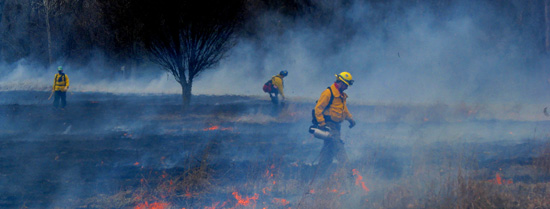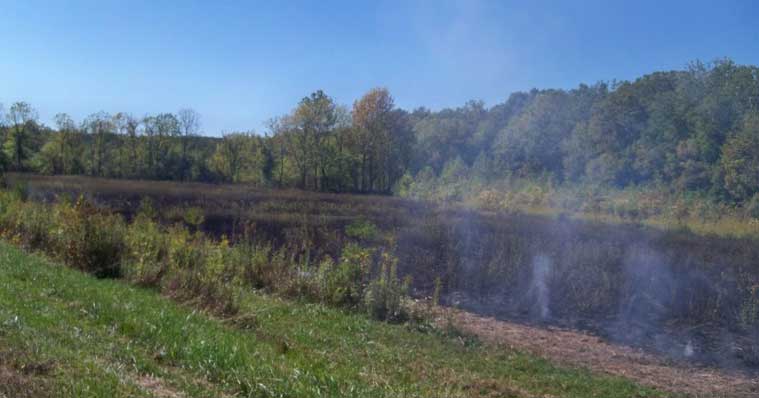
Understanding Fire Behavior
In order to implement a safe and successful prescribed burn, it is important to understand how various factors influence fire behavior. DNR prescribed burn workshops help landowners understand how wind, relative humidity, temperature, soil moisture, fuel moisture, air mass stability, and topography are to be considered when planning and implementing a burn. Aspect, slope, and terrain are three characteristics that can influence fire behavior related to topography. Aspect refers to the direction a slope faces. Slope is the degree of incline of a hillside. Terrain refers to the shape, or lay of the land. These elements influence flame height, rate of fire spread, how smoke produced from the burning vegetation will dissipate, and the overall success of meeting the burn objectives. For example: fires burn more rapidly uphill than downhill, fires burn faster and hotter the steeper the slope, and terrain can influence the direction and rate of fire spread.
Planning a Prescribed Burn
A burn plan should always be developed for every proposed prescribed burn. A burn plan is an all-inclusive document that includes a description of the site to be burned and the objectives of the burn. A burn plan helps to provide detailed information to everyone involved in implementing the burn or affected by implementation of the burn, such as members of your fire crew, the local fire department, sheriff’s department, and neighbors. There are four primary components to planning a prescribed burn. These components include:
- Regulation review.
- An evaluation of the prospective burn site.
- Preparation of a burn plan for the site.
- Pre-burn site and equipment preparation.
Some information included in a burn plan are maps, burn objective, burn unit description, adjacent land description, areas of special concern, pre-burn site preparation, equipment needs, personnel needs, persons to be contacted, and acceptable burning parameters. Acceptable burning parameters include time of year, time of day, relative humidity range, wind speed range, temperature range, soil moisture, allowable wind directions, firing methods, and fire escape contingency plan.
Those attending a DNR prescribed burn workshop will learn about and discuss topics such as control lines (firebreaks), firing techniques, appropriate burning apparel, ignition sources, completing a pre-burn checklist, conducting the prescribed burn, in case of emergency, post-burn evaluation, and smoke management.
Smoke management is likely one of the most overlooked but possibly most important aspects of prescribed fire. It is the responsibility of those conducting a prescribed burn to minimize any detrimental effects that smoke from the fire might create. DNR prescribed burn workshops cover this topic in more detail, but some example guidelines that should be used to reduce the detrimental effects of smoke are:
- Consider all on-site and off-site impacts that smoke might affect when planning a prescribed burn.
- Use the most up-to-date weather information prior to the burn to help assess smoke behavior and movement.
- Conduct prescribed burns on days when conditions will allow the smoke to rise and dissipate quickly.
- Use extreme caution when smoke-sensitive areas are adjacent to or downwind of the proposed burn area.
As a general rule, do not burn if smoke-sensitive areas are downwind of the burn area and within one-half mile. Please note: The desired vegetation response may not be immediately apparent after the burn. Assessing changes in vegetation diversity and density has to be delayed until the entire growing season can be evaluated. So, it is important to return to the site several times during the growing season to fully assess the results.

